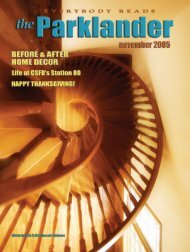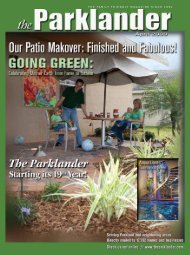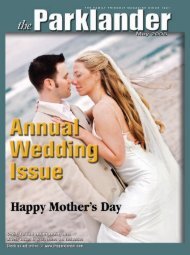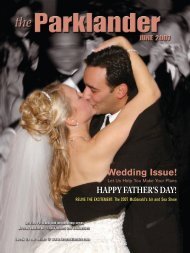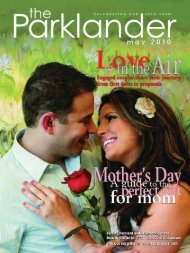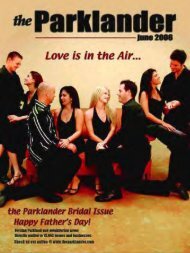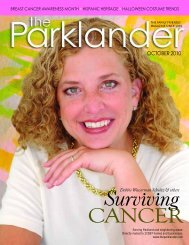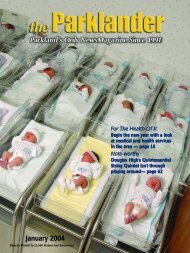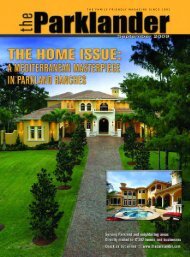September 2008 - The Parklander Magazine
September 2008 - The Parklander Magazine
September 2008 - The Parklander Magazine
Create successful ePaper yourself
Turn your PDF publications into a flip-book with our unique Google optimized e-Paper software.
SENIOR CONCERNS<br />
My House or Yours<br />
By Carol Rakoff, R.N.<br />
I figure that by the time I’m 104, I’ll be ready to move into an<br />
independent living facility.That is, if my kids haven’t committed me<br />
sooner. It’s funny, but it’s so easy for me, as a healthcare provider, to<br />
recommend this type of living arrangement to my patients, but I<br />
personally feel that I will be resistant to ever giving up my home and<br />
my independence.<br />
I have a 72-year-old gentleman patient who just lost his wife and<br />
now lives alone. He is not physically fit and appears to be much<br />
older. When I last visited his home, he answered the door with a<br />
plate of nine cookies on it. He said he had made pasta for dinner, but<br />
I really doubted it. He can no longer drive due to poor vision, and is<br />
resistant to getting help. I strongly recommended to him that he<br />
investigate an independent living facility that also has assisted living<br />
beds. I told him it would be like renting an apartment in an adult<br />
hotel. He would have a dining room to go to for meals (no more<br />
cookie dinners), and I told him I knew of a place where the dining<br />
room is open all day long and he could get a meal at any time! He<br />
could bring some of his furniture, pictures, mementos, and anything<br />
else that would fit into the rooms and not be a safety hazard. <strong>The</strong>re<br />
are planned activities, day trips, and social opportunities. No one<br />
should have to sit in their home and be alone all day.<br />
I also have a friend who is an active, energetic woman, still<br />
volunteering in the community and contributing her knowledge.<br />
She lives in an independent/assisted living facility with her husband<br />
and is very content with the arrangement. I see her out around town<br />
at meetings all the time. She travels to see her grandchildren and<br />
attends family functions. She is truly “renting an apartment” in a<br />
facility with services.<br />
I always tell my patients or friends to choose a facility that it is<br />
closest to a family member, friend or family doctor. Of course that<br />
makes it easier for one of them (not the doctor), to visit when you<br />
are under the weather. If that is not a necessity for you, then you<br />
have many options. First impressions count. Is the facility<br />
aesthetically appealing to you I remember when I lived in New<br />
York City; we judged an apartment building by its snob appeal,<br />
i.e., the furnishings in the lobby. That can be a very important<br />
element for some people. But you do need to feel good every time<br />
you go home. Other important things to consider: do you know<br />
anyone there; does it pass the “sniff test”; have you heard<br />
anything (positive or negative), from friends, physicians, and<br />
neighbors Go back a few times and at different times of the day.<br />
Sit in the lobby and observe “the action”. Is the staff friendly Do<br />
they smile and say hello when passing you Also, try to speak to as<br />
many residents and visitors as possible. Maybe ask to sample a<br />
meal. Try more than one to be safe.<br />
Take your time and look around at different communities. Discuss<br />
all the possible living conditions available in your community. Don’t<br />
be so fast to run back up north. Remember—you’ll still have to deal<br />
with the ice, snow, and freezing cold. Besides, we’re just coming into<br />
hurricane season and you certainly don’t want to miss all the fun.<br />
130 SEPTEMBER <strong>2008</strong>








